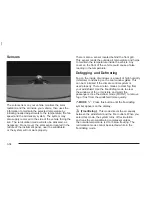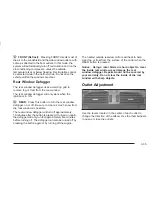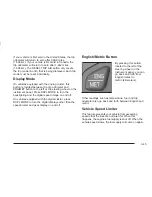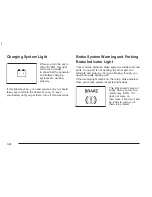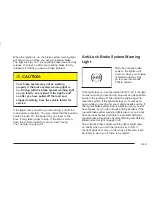
OFF: Turn the mode knob located on the rear climate
control panel to this position to turn off the airflow.
If the PASS OFF button located on the main climate
control panel is pressed, the rear climate control system
will be turned off and the settings selected for the
main climate control panel will also be selected for the
rear seat passengers.
For more information on how to use the climate control
system, see Dual Climate Control System on
page 3-31. For more information on the air outlets, see
Outlet Adjustment on page 3-35.
Automatic Operation
AUTO (Automatic): Press the MODE button until
AUTO appears on the display to place the system in
automatic mode. When automatic operation is active, the
system will control the inside temperature, the air
delivery mode and the fan speed.
Manual Operation
y
MODE
z
: Pressing this switch cancels automatic
operation and places the system in manual mode. Select
the AUTO mode to return to automatic operation.
To change the current mode, select one of the following:
F
(Vent): This mode directs air to the upper outlets,
with some air directed to the floor outlets.
*
(Bi-Level): This mode directs half the air to the
upper outlets, and then directs the remaining air to the
floor outlets.
7
(Floor): This mode directs the air to the floor
outlets.
y9z
(Fan): Pressing this switch cancels automatic
operation and places the system in manual mode.
Press this switch to increase or decrease the fan speed.
Press the MODE switch until AUTO is displayed to
return to automatic operation.
y
TEMP
z
(Temperature): Press this switch to
increase or decrease the temperature for the rear seat
passengers.
For cool air to be sent to the rear of the vehicle, the
air-conditioning system on the main climate-control
panel must be on. If it is not on, then the temperature in
the rear of the vehicle will remain at cabin temperature.
Be sure to keep the area under the front seats clear
of any objects so that the air inside of your vehicle can
circulate effectively.
3-37
Summary of Contents for 2004 DeVille
Page 5: ...These are some examples of symbols you may find on your vehicle v...
Page 6: ...NOTES vi...
Page 126: ...NOTES 2 62...
Page 129: ...NOTES 3 3...
Page 130: ...Instrument Panel Overview 3 4...
Page 169: ...Analog Cluster United States version shown Canada similar 3 43...
Page 280: ...NOTES 4 46...
Page 292: ...Engine Compartment Overview When you open the hood you will see 5 12...
Page 388: ...NOTES 5 108...
Page 402: ...Engine Drive Belt Routing 6 14...












